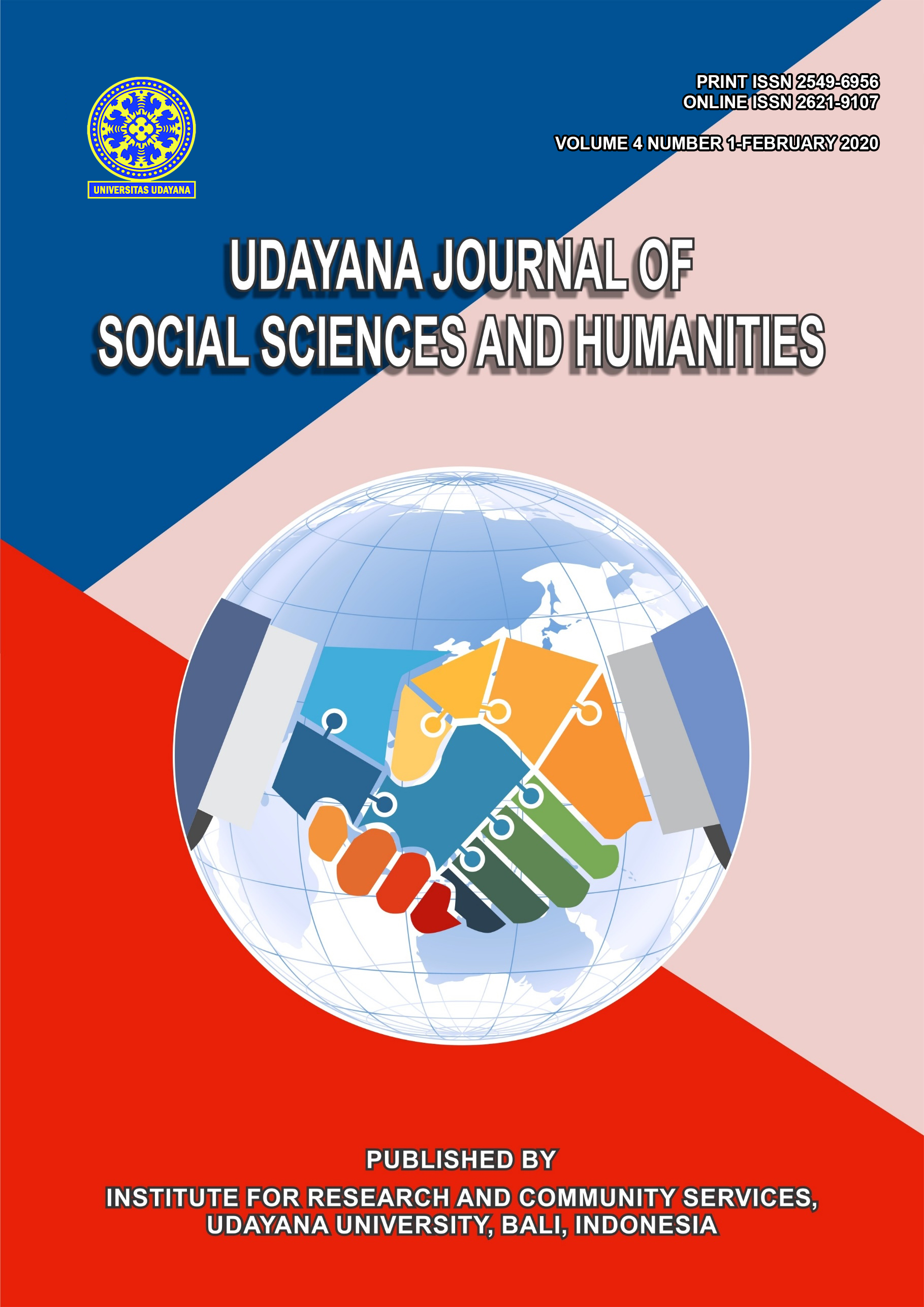The External Conflict Faced by The Main Character in Five Feet Apart Movie
Abstract
The title of this study is The External Conflict Faced by The Main Character in Five Feet Apart Movie. This study focused on the external conflict faced by Stella Grant, the main character. The data of this study were taken from the Five Feet Apart movie and its script through documentation method and note-taking technique. The data is analyzed through qualitative research according to the theory of literature proposed by Kenney (1966) and Bernhardt (1953). Based on the analysis, it found that the main character faced man versus man and man versus nature external conflict. Man versus man conflict happens mostly in the movie. Meanwhile, for the psychological aspects that trigger the conflict, it is found only three from five classes of human motives that appear in this movie. Those motives are wanting, emotions, as well as feelings and attitudes.
Downloads
References
Arif M.A., I. Parthama, & S.A.I.Maharani. (2017). Conflict Analysis of Main Character in The Novel “The Fault in Our Stars” By John Green. Humanis. Vol 17, No 1, October, pp 20-26.
Bernhardt, K.S. (1953). Practical Psychology. McGraw Hill Book Company, Toronto.
Cattrysse, P. (2010). The Protagonist's Dramatic Goals, Wants, and Needs. Journal of Screenwriting. Vol 1, No 1, pp 83-97.
Cresswell, J.W. (2009). Research Design Qualitative, Quantitative, and Mixed Methods Approach (3rd Edition). SAGE Publication United States of America, Los Angeles.
Dewi, L. C., Sutapa, G., & Suhartono. (2019). An Analysis of The Main Character’s Conflicts In “Thirteen Reasons Why” By Jay Asher. Jurnal Pendidikan dan Pembelajaran. Vol 8, No 7, pp 167-177.
DiYanni, R. (2001). Literature: Reading, Fiction, Poetry, and Drama. McGraw Hill Higher Education, Singapore.
Egri, L. (1923). The Art of Dramatic Writing. Simon and Schuster, New York.
Ermalina, P. Rahayu, Erippudin. (2015). Analysis of The Main Characters Of “The Lord of The Ring- The Return of The King” A Novel By J.R.R Tolkien. Journal Mahasiswa Prodi Bahasa Inggris. Vol 1, No 1, pp 1-7.
Hanna, I. (2016). an Analysis of The Main Characters’ Conflicts in Jane Austen Novel Entitled “Sense and Sensibility”. Wacana Didaktika. Vol 4, No 2, pp 156-170.
Kenney, W. (1966). How to Analyze Fiction. Monarch Press, New York.
Klarer, M. (2004). An Introduction to Literary Studies (2nd Edition). Taylor & Francis Library, New York.
Kothari, C.R. (2004). Research Methodology, Methods, and Techniques (2nd Revised Edition). New Age International (P) Limited Publishers, New Delhi.
Luke, J.L. and M.M, Catherine. (2012). Toward Peace: Using Literature to Aid Conflict Resolution. Childhood Education Journal. Vol. 71, Issue 2, pp 66-69.
Marlia, M., Puspasari, A., & Hikmahyanti, C. (2019). Character Analysis in The Movie Alice Through the Looking Glass Based on Propp’s Theory. Jurnal Ilmiah Bina Bahasa. Vol 10, No 2, pp 25-36.
Meredith, R.C. and J.D, Fitzgerald. (1972). Structuring Your Novel: From Basic Idea to Finished Manuscript. New York: Barnest and Noble Book.
Mulyawan. I.W. (2009). Recount of a Traveler’s Life in Child’s Story (Plot Construction Analysis). Nuansa Indonesia. Vol. IX, No. 2. August, pp 168-172.
Mulyawan. I.W. (2015). Three Dimensional Aspects of the Major Character in Oscar Wilde’s Vera. Phenomena Journal of Language and Literature. Vol.15, No.1.
Nugroho, M., & Viladinia, S. (2018). Audrey Turner’s Conflicts and Defense Mechanisms in Kinsella’s 'Finding Audrey'. Jurnal Bahasa dan Sastra. Vol 3, No 1, pp 45-54.
Özyildirim, G & K. Kayikçi. (2017). The Conflict Management Strategies of School Administrators While Conflicting with Their Supervisor. European Journal of Education Studies, Vol. 3, No. 8, pp 1-20.
Patmarinanta, A. & P. Ernawati (2016). Study on Characterization of the Main Character in “The Fault in Our Stars”. Research in English and Education. Vol 1, No 1, August, pp 26-33.
Putra, I. (2016). The Analysis Character and Conflict In The Movie “The Hangover III”. English Department of Udayana University, Denpasar.
Rachmawati, P. (2018). The Analysis of Conflicts Reflected by Main Characters in “Rise Of The Guardians” Movie. Jurnal Ilmiah Bahasa dan Sastra. Vol 5, No 2, pp 66-76.
Rahmah, N., S.D. Kuncara, N.M. Valiantien. (2017). The Influence of Psychological Conflict Toward Elsa's Character Development in Frozen Film. Jurnal Ilmu Budaya. Vol 1, No 2, April, pp 59-72
Saputra, I. (2018). Conflict Analysis in Stromberg’s Movie “Maleficent”. Humanis. Vol 22, No 4, pp 871-881.
Sari, D.Y. (2013). A Study on The Main Character’s Internal and External Conflicts in Extremely Loud and Incredibly Close Movie. Jurnal Ilmiah Mahasiswa FIB. Vol 3, No 1.
Sari, A.F.M., Y. Morelent, D. Putri. (2018). The Conflict of Main Character and Character Education Values in the Novel Koala Kumal by Raditya Dika. Kumpulan Artikel Wisudawan/i Periode ke 70. Vol 8, No 2.
Thamrin, N.R. (2013). The Character Analysis of Glen Hansard in Once Film. English Review: Journal of English Education. Vol 2, No 1, December, pp 37-48.
Tjosvold, D & M.M, Tjosvold. (1995). Psychology for Leaders. John Wiles & Sons, Inc, New York.
Truman, Y., S.D. Kuncara, R. Setyowati. (2017). Analysis of The Main Character Needs in Life of PI Movie Using Maslow's Theory. Jurnal Ilmu Budaya. Vol 1, No 1, January, pp 43-58.
Walliman, N. (2011). Research Method, the Basic. Taylor & Francis e-Library, New York.
Wellek, R & A, Warren. (1966). Theory of Literature. Cox and Wyman Ltd, London.
Wellek, R & A, Warren. (1973). Theory of Literature. Harcourt, Brace & World, New York.
Zaim, M. (2014). Metode Penelitian Bahasa: Pendekatan Struktural. Sukabina Press, Padang.






